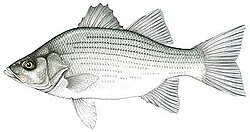White Bass
| WhiteBass | |
|---|---|
 |
|
| White bass | |
| Scientific classification | |
| Kingdom: | Animalia |
| Phylum: | Chordata |
| Class: | Actinopterygii |
| Order: | Perciformes |
| Family: | Moronidae |
| Genus: | Morone |
| Species: | M. chrysops |
| Binomial name | |
|
Morone chrysops (Rafinesque, 1820) |
|
| Synonyms | |
|
|
The white bass, silver bass, or sand bass (Morone chrysops) is a freshwater fish of the temperate bass family Moronidae. It is the state fish of Oklahoma.
White bass are distributed widely across the United States, particularly in the Midwest. They are very abundant in Pennsylvania and the area around Lake Erie. Some native ranges of the white bass are the Arkansas River, Lake Erie near Cleveland, Ohio, and Lake Poinsett in South Dakota; they are abundant in the Winnebago lakes system of Wisconsin; and they are also very abundant in Oklahoma. White bass have also been found in rivers that flow to the Mississippi. Native to many northern habitats, they have been introduced in many different waters around the United States, particularly in southern locations. They were also successfully introduced to Manitoba starting in the 1960s, where they have gained importance as a sport fish.
The species' main color is silver-white to pale green. Its back is dark, with white sides and belly, and with narrow dark stripes running lengthwise on its sides. It has large, rough scales and two dorsal fins. The more anterior dorsal fin is much harder and appears to have spines on them. Although these are not true spines, this type of fin is called a spinous ray. The more posterior of the two dorsal fins is much softer, and is thus called a soft-ray. Because the vertebrae do not extend into the tail, the white bass has what is called a homocercal tail. The body is deep and compressed laterally. Most grow to a length between 10 and 12 inches (25 and 30 cm), though they can reach 17 inches (43 cm) or more. Because the dorsal and ventral portions of the its tail angle inward toward a point to create a clear angle, the tail is said to be notched.
The record size for white bass caught on fishing tackle is 6 pounds 13 ounces (3.1 kg) shared by fish caught in 1989 in Orange Lake, Orange, Virginia, and in 2010 in Amite River, Louisiana.
White bass are carnivores. They have four main taxa in their diet: calanoid copepods, cyclopoid copepods, daphnia, and leptodora. They are visual feeders. When not frightened, they will bite readily at live bait such as worms and minnows. Only the largest fish will feed on other fish, and as the summer season progresses, there is an overall trend towards eating fewer fish. Fish that are able to accumulate lipids over the summer are better able to survive cold winters. When looking at midwestern white bass, particularly in South Dakota, diet overlap occurs between the bass and the walleye. As seasons progress through the summer and fall, the amount of diet overlap decreases as a result of both fish increasing in length.
...
Wikipedia

